Djadja problem and its solution
In our report
on the Livingston Chess960 Computer World Championship in Mainz earlier this
month we showed you a problem which human beings and computers were not supposed
to be able to solve.
We got the position from the Computer Championship arbiter Hans Secelle of
Belgium. He gave it to us on a sheet of paper, which we dutifully showed to
the chess players who wandered by. It was from a study by an unknown (to us)
composer, with the initial play left out. Here is the position:
 D.
Djaja 1972
D.
Djaja 1972
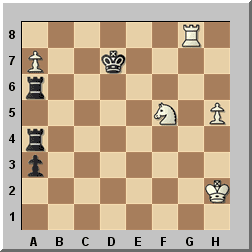
White to play and draw
In his book "The King" GM Jan Hein Donner writes: "White makes
one more move and it’s a draw! Keres, the two Byrnes, Lothar Schmid, Bisguier
and I sat staring at this position for more than half an hour. We couldn’t
find it. Can you?"
Hans was convinced that computers would also fail miserably. So Frederic Friedel
bet him a glas of whisky at the bar that Rybka would find the key move. "Not
necessarily understand why it holds the draw," Friedel said, "but
it will find the move by discovering that all other moves lose badly and quickly."
Hans lost his bet, Rybka found the right strategy in one minute and two seconds.
Before we give you the very interesting solution (and release a large number
of readers from their suffering) here are some of the top grandmasters who wrestled
with the problem in Mainz, and some cute little stories surrounding their efforts.
One of the first players we showed the problem to was Levon Aronian (on the
right in the above picture) between his games in the GrenkeLeasing Rapid World
Championship. He solved it instantly, but with a little confession: "I
know this position, I have read the Donner book!" Lev had a prediction:
"Show it to Gabriel Sargissian," he said [Gabriel is his second, left
in the picture above]. "That guy is a problem solving wonder. He gets any
study and any problem immediately. It's a miracle." No he doesn't. Gabriel
was unable to find the solution, and after some taunting by Levon and us he
asked for us to reveal it. Which we did.
Next we showed the problem to Evgeny Najer, rated 2663, Daniel Fridman, 2665,
and David Navara, 2709 (left to right in the picture above) – and to any
number of GMs in the hall. None solved it on the spot. Late that evening Fridman,
who spent a lot of time working on it, came up with the solution.
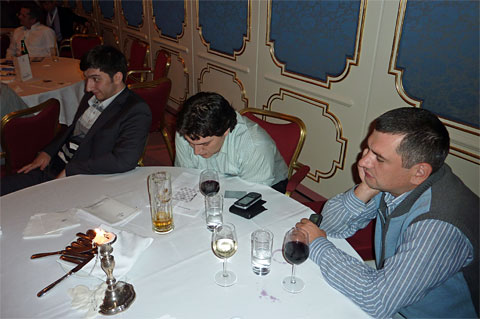
That evening at the Champions' Dinner everyone got to try: in the above picture
it is Vugar Gashimov, rated 2740, his brother and manager Sarkhan, IM elect
rated 2351, and Viktor Bologan, 2689. At the same table was also Ivan Sokolov,
2655, Ordix Open winner Shakhriyar Mamedyarov, 2717, and other passing GMs.

Guess which of the Gashimov brothers solved the puzzle. The one who is weaker
at over-the-board chess, by almost 400 Elo points! Sarkhan is a project manager
of Hewlett-Packard in Azerbaijan, speaks excellent English and has a great sense
of humour. He spells his surname "Hashimov", but that is a Russian
thing. We must remember to keep in touch with him.

Shakhriyar Mamedyarov was another Super-GM who solved the problem – after
a number of local tap beers and some intense brooding over our sheet of paper.
Another episode needs to be narrated, but we will keep the protagonists anonymous,
for obvious reasons. One top GM we showed the puzzle to – not necessarily
one of those mentioned above – worked for a while on the problem and then
gave up. Some time later he asked to see it again, and this time, after a few
minutes of thinking, a smile broke out on his face and he gave us the correct
solution. Very nice. Except that later that evening a young and somewhat distraught
lady told us the following: "He came outside and asked us for the solution,
and the whimp (Gabriel) told him! He said not to tell you, but I can't allow
it to pass." Very devious – but hey, we like that in a man.
Finally there is Garry Kasparov, enjoying a vacation on a Mediterranean coast,
but still keeping up with the chess news. He called and told us that he had
solved the puzzle in a minute or two. "But only because of the big hint
you included in the story!" Garry said. His reasoning, as he explained
it, was the following: "if Rybka takes over a minute – that long!
– to find the solution, in an open position, then there is only one
possibility: it must be a perpetual! Once you know that the solution is easy
to find...". Good thinking, Garry Kimovitch!
Well, here at last is the solution for all our patient and long-suffering readers.
The study is taken from Donner's book and can be found on this Chessville
review page. Donner says that the Djaja study was circulated in the Skopje
Olympiad, 1972, and brought many of the participants to despair. Here it is
in its entirety:
Study by Yugoslav composer Djaja

White to play and draw
White’s position appears hopeless as there is no way of stopping the
Black pawn’s march to become a queen. For example, 1.Nf5+ Kd8 2.Nxd4 a2
3.Nc2 Rb2 and Black wins. Our computers tell us that White can probably defend
with 2.Nxd4 a2 3.Rb7 a1Q 4.Rxb6 Qxd4 5.a7. However, let us concentrate on the
main line: 1.Nf5+ Kd8 2.Ra8+Kxd7 3.a7 Ra4 4.Rg8 Rba6 brings
us to the position we were circulating in Mainz:
In this position you have to find a single white move, and then spend a few
seconds explaining why it is a draw. The solution is 5.Nh6!!
The words you must add are "...and now White has perpetual check along
the g-file!" Check it out: the rook is proctected on every square the black
king can use to approach: g1-g3 by the white king, g4 and g8 by the knight,
and g6 by the pawn. The only unprotected squares, g5 and g7, cannot be used
by the enemy king, since f5 and f7 are attacked by the knight. [Click
to replay the study]
Isn't that a clever little puzzle? But how are computers able to solve the
problem? When we took our bet with Hans Secelle the intention was to use the
"Monte Carlo"
function of Rybka, in which the program plays thousands of games against
itself at high speed and discovers that, although it may not understand why,
one move simply does not produce wins for the black side (while all others do).
However Rybka does it on a normal level as well:
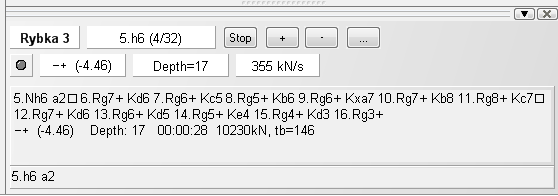
Above is Rybka running on a standard quad system: the solution pops up in just
28 seconds, and remains permanently the main line of the program. But what about
other engines?

This is good ol' Fritz, running on the same quad (at close to ten million positions
per second). The program comes up with the solution and stays with it after
just 32 seconds.
Send us an insoluble study!
That's that. Are there any studies that these monsters cannot solve? Anyone
who sends us a nice puzzle – something as elegant as the position above
– which chess engines cannot figure out, can win a Deep Fritz 11 signed
by all the players of the Dortmund tournament. Maximum three. Please use the
feedback button on the left side of this page and give "Computer puzzle"
as the subject line (anything else may cause your letter to be ignored). And
please give us the position and solution in PGN.
Rybka 3 – Computer Chess World Champion
Rybka 3, the world’s strongest chess program, leads all ranking lists clearly,
with ratings well above Elo 3000. The name translates to "little fish", and
Rybka is the shooting star of computer chess and the reigning world champion,
having won its title in Amsterdam 2007. But strength is not everything. Today
the main use of chess software is interactive analysis. Rybka's superior playing
strength helps you to quickly assess a position. But analysis with Rybka 3 is
much more than just evaluations and best moves. In the user interface designed
by ChessBase, Rybka 3 introduces several ground-breaking new analysis features.

Prices
Note that Rybka 3 includes a database of one million games, and that the purchase
of the program entitles you to one year of access to the chess server Playchess.com.
Rybka 3 is a UCI engine, with 32 and 64-bit versions included in the package.
Rybka can be made the default engine in ChessBase 10. Order
Rybka now!
Links
 FRITZ
11 and Deep Fritz 11
FRITZ
11 and Deep Fritz 11
A year ago Fritz became the first commercial chess program in history to defeat
a reigning World Champion in a formal
match. Hundreds of thousands of chess fans followed the event on the Internet.
In its games against Vladimir Kramnik Fritz displayed an astonishing degree
of strategic understanding, underscoring its reputation as one of the strongest
and best-loved chess programs in the world.
The new Fritz 11 – now availabe in the ChessBase
Shop – has been vastly improved, compared to the version that beat the world
champion. Its playing strength has improved by 80 Elo points. But it is also
the entire package of new features that will impress chess fans. The program
helps you with practical play, training and analysis, and does so in an entertaining
way that fosters learning and understanding.
The main Fritz database contains over one million games, ranging from the years
1625 to 2007 – from the early beginnings of chess history to the latest top-level
tournaments. The revised and extended openings book is more diverse and better
tuned to the strengths and preferences of Fritz. A complete new feature, the
“magic eye”, visualizes the thought processes of the engine on the 3D chessboard.
You can directly follow the ideas that are going through the “mind” of the program.
Here's
an interesting article on the Advantages of Deep Fritz 11, written
by one of it's programmers, Mathias Feist.
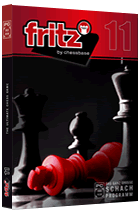 |
System requirements: Pentium III 1.4 GHz or higher,
256 MB RAM, Windows XP or Windows Vista, GeForce5 or compatible graphics
card with 128 MB RAM or higher, 100% DirectX compatible sound card,
Windows Media Player 9, DVD ROM drive.
Fritz 11 costs 49.99 €uros
Deep Fritz 11 costs 99.90 €uros
|
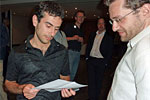


















 D.
Djaja 1972
D.
Djaja 1972
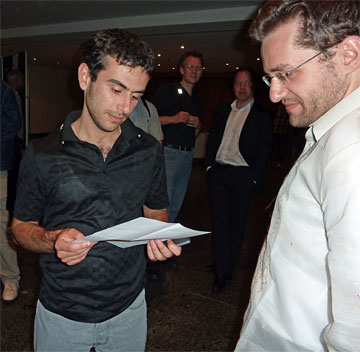









 FRITZ
11 and Deep Fritz 11
FRITZ
11 and Deep Fritz 11





